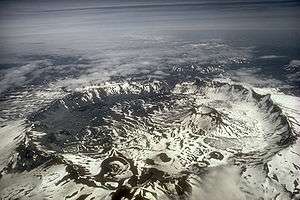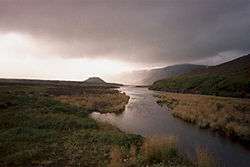Mount Aniakchak
| Aniakchak Caldera | |
|---|---|
 Mount Aniakchak caldera | |
| Highest point | |
| Elevation | 4,232 ft (1,290 m) [1] |
| Coordinates | 56°51′47″N 158°07′47″W / 56.86306°N 158.12972°WCoordinates: 56°51′47″N 158°07′47″W / 56.86306°N 158.12972°W [1] |
| Geography | |
 Aniakchak Caldera Alaska | |
| Location | Aniakchak National Monument and Preserve, Alaska, U.S. |
| Parent range | Aleutian Range[2] |
| Topo map | USGS Chignik D-1 |
| Geology | |
| Mountain type | Caldera[2] |
| Volcanic arc/belt | Aleutian Arc |
| Last eruption | May to June 1931[1] |
| Designated | November 1967 |

Mount Aniakchak is a 3,700-year-old volcanic[2] caldera (about 10 kilometers (6 mi) in diameter) located in the Aleutian Range of Alaska, United States. The area around the volcano is the Aniakchak National Monument and Preserve, maintained by the National Park Service. In November 1967, Aniakchak Caldera was designated as a National Natural Landmark by the National Park Service.[3]
Geological history
Aniakchak caldera formed during a major eruption of VEI=6, which left evidence in ice cores dated to 1645 BC.[4]
Since then, more than 20 eruptions have occurred from vents on the caldera floor. Vent Mountain has been the source of numerous eruptions of ash, bombs, and lava flows since the formation of the caldera. From 1500 BC to AD 1000 four lava domes were extruded on the caldera floor. Textural evidence indicates that these lava-dome eruptions occurred beneath Ancient Surprise Lake which was as deep as 100m. Ancient Surprise Lake drained catastrophically before about AD 1000. (Surprise Lake is now about 2.75 km2 (680 acres) in area and up to 19.5 m (64.0 ft) deep.) Prior to or immediately after this draining, explosive eruptions of andesitic magma produced a cluster of three tuff cones in the southeastern part of the caldera.
Around AD 1500, during one of the most violent events in recent history at Aniakchak, an estimated 0.75 to 1.0 km3 of material destroyed a preexisting edifice at Half Cone and inundated most of the caldera floor with pyroclastic flows, surges, and fallout many meters thick. During the final phase of this eruption, a lava flow filled the basin formed during the collapse of Half Cone.
Several more recent prehistoric eruptions occurred in the summit crater and along the south flank of Vent Mountain producing a field of blocky dacite lava flows against the south wall of the caldera. Minor eruptions immediately west and east of Vent Mountain produced a small scoria cone (Blocky Cone) and two maar craters (now water-filled) along the base of the southeast caldera wall.
European-descended geologists discovered the volcano in 1922.
The volcano's only eruption in modern recorded history occurred in 1931. The Jesuit "Glacier Priest", Father Bernard Hubbard, made record of it: "A small but impressive explosion pit was added to the pockmarked caldera floor that year. Many thousands of tons of ash lay strewn within the caldera and scattered up to 40 miles away over the small villages".[5]
Surprise Lake
Surprise Lake within the caldera is the source of the Aniakchak River, a National Wild River.


See also
References
- 1 2 3 "Aniakchak Peak". Geographique Names Information system. United States Geological Survey. Retrieved 2015-05-05.
- 1 2 3 "Aniakchak". Global Volcanism Program. Smithsonian Institution. Retrieved 2009-01-19.
- ↑ "Aniakchak Crater". National Park Service. 2004-02-05. Archived from the original on 2010-05-28. Retrieved 2009-01-19.
- ↑ Pearce, N. J. G., J. A. Westgate, S. J. Preece, W. J. Eastwood, and W. T. Perkins (2004). "Identification of Aniakchak (Alaska) tephra in Greenland ice core challenges the 1645 BC date for Minoan eruption of Santorini". Geochem. Geophys. Geosyst. 5 (3): Q03005. Bibcode:2004GGG.....5.3005P. doi:10.1029/2003GC000672.
- ↑ "Aniakchak National Monument & Preserve", pulled from chranger.com, 3 June 2011.
External links
- Alaska Peninsula Trek
- Alaska Volcano Observatory
- Volcanoes of the Alaska Peninsula and Aleutian Islands-Selected Photographs